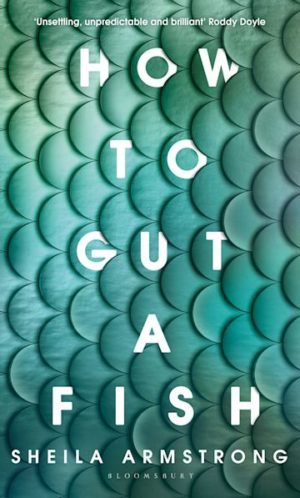You have no items in your cart. Want to get some nice things?
Go shopping
Sheila Armstrong’s debut collection of short stories begins with a literal opening: on the longest night of the year, a hole appears in the middle of a farmer’s field. Although there’s something vaguely threatening about this sudden falling away of earth, this is not, as the blurb suggests, a story in which “Villagers, one by one, disappear into a sinkhole beneath a yew tree.” Instead, it’s more a series of encounters with the sinkhole, although even “encounter” feels like too strong a word here. It’s more like we’re allowed to watch the life that happens around the hole: the 14-year-old girl who needs to relieve her bladder after a date at the cinema, the badger who decides to build her set elsewhere when she scents something not-quite-right about the area, the mushroom foragers navigating their way through post solstice-party hangovers. The hole functions like the dark aperture of a video camera in a nature documentary – an unmanned, stationary recording device left to capture whatever comes its way, and part of the thrill of the story comes from seeing who it is that starts snuffling around, unaware of the fact that they’re being observed. And the observation itself is beautiful, both in this story and throughout the entire book. You can turn to pretty much any page, jab any line, and the odds are good that you’ll hit upon a quietly stunning sentence:
The evening is greyscaled, but the hares’ eyes are copper holes.
The air is sawdust, warm and dull, and the sweet smell of burnt timber licks up from under the buzzsaw.
Buoyancy aids pile up, red and sweating, rimmed with white tide marks.
This technique of choosing a centre and then documenting the lives and events in its vicinity feels consistent throughout the collection, though its effects vary. It’s particularly affecting in both “hole” and the final story, “dome.” “dome” essentially describes a day at the beach, but the accretion of all these beautifully observed moments – the early dippers “skin-bagged around the hips,” the tourists buying “resin-cast fridge magnets,” the suffering of the kayaking instructor as “the salt itches his psoriasis-scaled armpits” – somehow manages to make everything add up to more than itself, building to an end that’s genuinely transcendent. It’s as if the story really has created a dome over the scene it describes. This does something genuinely astounding, in that it allows the reader to feel they can apprehend everything in the story simultaneously, even though it’s been fed to us in linear fashion. There’s something painterly about this effect, though that doesn’t quite catch it either, since it can’t account for how the story skilfully handles the passing of time.
Accumulation of detail isn’t something that’s typical of the short-story, a form whose watchwords are “focus” and “compression.” The standard advice is that to write a successful literary one, you need to cut away everything that’s extraneous (although what counts as “extraneous” is up for debate). This logic is successfully challenged in ensemble pieces like the ones discussed above, where spinning out from a centre and collecting ever more material means that by the end everything has coalesced into something that’s recognisably story-ish. But the stories that plunge a smaller cast of characters into a centrifuge seem to create the opposite effect. In “haptic,” for example, we start with Sofia smoking on a balcony at a fairly sedate house party/birthday party; we proceed to head-hop to the birthday boy and the other guests, getting a bit of each one’s backstory; there’s the presentation of the birthday gift, a bit more head-hopping, and we’re done. There’s the hint of a will-they-won’t-they tension between two of the characters – an intrigue that’s repeated for another pair in “star jelly” – but focussing fairly equal amounts of attention on everyone means it’s difficult to feel particularly invested in any one character.
Something about the prose itself contributes to this odd flattening effect. Even though we have access to characters’ thoughts and even though a few stories, by being in the second person, seek to make the experiences described happen to the reader directly, there’s still a barrier to empathy. For many of the stories I can remember what happened but not very much about who they happened to. The title story, “the skellington dance,” and “hold fast” all elicited the curious sensation of watching a documentary with the volume turned down, of the voice-over being withheld. This lasting impression of soundlessness sent me flicking back through the collection to find that there is in fact very little speech, and what there is tends to be terse and indirectly reported. Apart from the three stories in the second person, all bar one are in the third person, and this, alongside the lack of dialogue, means that we miss out on the inflections of both a character’s interior and exterior conversations. At worst, this makes the characters interchangeable; at best it means they are remembered by their actions or situation: the girl who went to see the Northern Lights by herself (“hold fast”), the mum whose son was born with a crooked spine (“the skellington dance”), the fisherman who gets involved in something dodgy that goes badly for him (“how to gut a fish”).
Two stories mark a departure in point of view and style: “mantis” and “instinct.” “instinct” is a surreal story written in the first-person plural and reads like a cross between George Saunders and Leonora Carrington, with some Donald Barthelme thrown in for good measure (I mean this in an overwhelmingly positive way.) The surreal element can’t be discussed without ruining the ending, but it concerns the fate of the narrating couple and their baby: they adopt a dog through a personal ad, bring it into their lives and their flat, and things go well until they don’t. The voice is fully alive and genuinely funny, and that kind of range from an author who’s also nailed lyricism is properly impressive. I was less taken with “mantis,” which is written in first person but frequently drops the “I” pronoun. It’s the sort of stream-of-consciousness where a lot of the sentences end up sounding like a headful of jumbled notes-to-self:
Head is banging but need to find green rooftop cross for cough bottle where is it.
this road familiar now traffic lights walking man turned green maybe through here?
Even though we’re given direct access to the narrator’s telegraphed thoughts, the story left me surprisingly cold. The narrator’s isn’t an easy consciousness to inhabit, but his story is a tragic one, and not for the first time whilst reading this collection, I started asking myself if maybe this distance that I feel from the characters isn’t in fact some problem with the stories themselves but a failing on my part. That maybe I’ve recently had whatever gland is necessary for empathy accidentally cauterized or removed. I’m very much not discounting the possibility that other readers would easily empathise with the protagonist in “mantis,” or with any of the characters in the other pieces where I struggled. But I can’t shake the feeling that a lot of these stories, released in the midst of a pandemic, in some way embody the most insidious phrase to come out of the last couple of years: “It is what it is.” As if the way things are is inevitable, and the best solution is to be as affectless about it as possible.
I also can’t shake the feeling that this might be deliberately induced, or even provocative. Sheila Armstrong is clearly a talented writer – one who’s capable of a martialling an impressive array of techniques and, I would imagine, choosing which to use and which to withhold in order to create certain effects. There’s something about her refusal to use capitals for the titles of the stories, as well as the profusion of different kinds of animal across the collection, that makes most of the book feel like not just like a documentary but a documentary of minutiae. Or, going further than that, since she gives such a radical equality to each element of any given story, she questions the very distinction between minutiae and whatever its Latinate antonym might be.
Where things get really interesting is the point at which this approach to style is let loose on a medium-sized canvas. “red market”(long-listed for Galley Beggar’s 2020–2021 short-story prize) is, the blurb tells us, a story in which “a nameless girl is taped, bound and put on display in a countryside market,” and was inspired by news reports about human trafficking. Placing the girl on display as just one item amongst many – a stack of vintage porn mags, a Victorian diving suit, a Freddie Mercury figurine – was, the author explained to the Galley Beggar website, her way of “understanding the true horror of it.” The true horror of it for me – and here again, I worry that I might have to retake the Psychopath Test – is that the whole thing feels less ugly than it should. The girl is eventually harvested for organs, but the way that nothing goes to waste (again) puts me in mind of scenes in nature documentaries – in this case a time-lapse video where a carcass is picked clean by scavengers. Any expected outrage is further blunted by that saturation of detail, that cataloguing of minutiae, and the way we get spun out from what we thought was the crux of the story. The porn magazines just mentioned are a case in point. A guy buys the magazines to decorate the walls of his band’s rehearsal space; members join and leave the band, adding their various markings to the pasted-up pages – Sharpie moustaches, boot-prints, a bloodstain caused by a snapped guitar-string. We’ve fallen into other lives, other stories. And if even a stack of porn mags has a life, and if this life intersects with a hundred other lives and all their complex and interconnected stories, then what happens to the revulsion we should feel about the girl being taped, bound, and harvested? There’s a moment in the story where the affectless tone almost falters – when we’re told that the girl’s mother “will weep for her daughter every night for ten years until her heart clogs and falls to pieces while she is crossing a busy road.” But those 10 years of grief take up less narrative space than a few moments in the “life” of a jacket, or a scene between a stoned couple who are young and in love.
I’m left wondering if the question How to Gut a Fish asks us is: What do we do with so much stuff? There’s probably a case for comparing it to how we navigate the ultimate junkyard that is the online world. How we start on a seemingly linear tack but very soon, through hyperlinks and random ads and multitasking, we end up down rabbit holes that take us further and further away from where we started. To the point where we no longer care, or maybe even remember, where we started. And if we apply this sort of logic to life – if we can’t focus our attention for more than a few seconds before craving the endorphin kick of skipping to something new – then what happens to empathy? The collection, despite being titled in such a way as to suggest it might be some sort of instruction manual, doesn’t offer any obvious directions. The work begins, I think, beyond the final page.
How to Gut a Fish
By Sheila Armstrong
Bloomsbury Publishing, 224 pages
About Adam Ley-Lange
Adam Ley-Lange lives and writes in Edinburgh. He's currently trying to find an agent for his first novel, whilst working on his second. Adam is also an editor for Structo Magazine, which publishes short fiction, essays and poetry.



